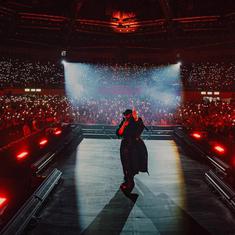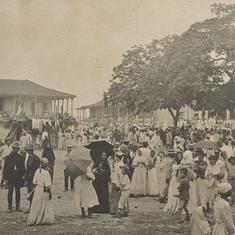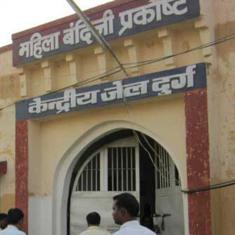The first European colonial foray into India, the historian Manu S Pillai notes, began with utter confusion. When Vasco da Gama and his Portuguese crew landed on the coast of Kerala in 1498, they went to a Hindu temple. Here, they participated in religious rites and prayed to a goddess. Da Gama and his crew were certainly not motivated by any feelings of religious accommodation towards people they would soon pillage and conquer. Rather, they believed they were in a chapel dedicated to the Virgin Mary and that the unfamiliar deities painted on the walls were actually Christian saints.
Da Gama’s mistake inaugurated a much longer history of confusion and misunderstanding. Pillai’s new book, Gods, Guns and Missionaries, examines this history in order to trace the genesis of modern Hindu identity and, more specifically, modern Hindu nationalism. Any account of Hindu nationalism must acknowledge the central role of history (both imagined and real). But Pillai delves back four centuries to identify critical changes in religious practice and belief.
This is a story which involves both VD Savarkar and Voltaire; Bible-thumping bureaucrats and Indophile savants who compared the Vedas to the Bible; and reformers who read Thomas Paine and reactionaries who caught the attention of Lenin. Perhaps confusion was an inevitable result of such a wide-ranging intellectual exchange.
In this episode of Past Imperfect, Pillai sorts out just how these various actors influenced one of the world’s oldest faiths.
A number of contemporary scholars have argued that Hinduism was “invented” during the colonial era. Pillai strongly disagrees. The idea of an invented Hinduism, he contends, grants far too little agency to Indians and disregards a much longer sense of a distinct Hindu identity vis-à-vis members of other faiths, such as Islam. Certainly, Hindu practice underwent dramatic change under colonialism. But Pillai prefers to see modern-day Hinduism, including Hindu nationalism, as only the religion’s latest avatar.
This avatar, he continues, has “one foot in tradition” and “the other in European sensibilities and confusion.” When the first European conquerors and missionaries landed on Indian shores, they displayed a profound aversion to the religion, fortified by ideas of Christian and Western superiority.
There were notable exceptions – the Italian Jesuit Roberto de Nobili styled himself as a Brahmin to win high-caste converts, even refusing to eat with other Europeans – but by and large they saw little value in Hinduism, and understood even less.
The Protestant Reformation in Europe, however, added a new dimension to this Eurocentrism. Now, Protestant missionaries brought to India certain ideas of what constituted religion: for example, strict monotheism and a single authoritative religious book. Hindu interlocutors, long accustomed to accepting multiple paths to God, were perturbed by the utter narrow-mindedness of their conquerors.
The European Enlightenment added a new veneer of confusion. Western scholars, often with far kinder attitudes towards Indian culture, drew on newly-translated Hindu texts to buttress their own critiques of Christianity. In this manner, they placed a premium on the Vedas, believing them to be an enlightened “single fount” of a religion which was later on corrupted into polytheism and idolatry. People like Voltaire were not above credulously accepting certain Vedic texts later discovered to be forgeries. As Pillai notes, Europeans’ “half-boiled theories” did not undergo much refinement: instead, they became infused with “power and certainty” via Western political and military ascendancy in the subcontinent.
Faced with missionary polemics and Western technological superiority, Hindu reformers fought back by coopting some of their conquerors’ ideas. Rammohan Roy, for example, tried to distill a rational monotheism from the body of Hindu belief and practice. This, Pillai argues, was an explicitly political project: Rammohan was keen on attacking both Eurocentrism and Western delusions about the religion. In the process, however, he helped kickstart the Protestantisation of Hinduism, rejecting parts of the faith that did not conform with post-Reformation religious notions – and, in the process, discounting much of its lived tradition and practice. Others, like Jotirao and Savitribai Phule, emulated missionary tactics, focusing on education.
Protestantisation brought about another key change: Hinduism evolved a defensive edge. Dayananda Saraswati, who subscribed to the idea of a Vedic golden age followed by decline in the Puranic era, was concerned with Hindu cohesiveness, keeping a watchful eye on Muslim and Christian proselytisation. His Arya Samaj, Pillai states, “was transformed into an organisation nobody had seen in India before: a Hindu evangelical movement.” Dayananda “became the grandfather of mass-based Hindu nationalism”.
Bal Gangadhar Tilak enhanced this defensive posture, popularising festivals to discourage Hindu participation in Muharram and consolidate a common religious identity across castes. But it was Savarkar who clinched the winning formula for Hindu nationalism. By focusing Hindu identity on a shared history, and arguing that this history consisted of a constant struggle for Hindu self-determination, Savarkar accomplished “a theoretical masterstroke.” He dismissed other aspects of Hinduism’s history, such as its tolerance and open-mindedness. “Tolerance was weakness,” Pillai sums up Savarkar’s worldview, “no matter how it was romanticised, when surrounded by intolerant faiths.”
As Pillai concludes, the triumph of Hindutva was not inevitable. Even if Hindu nationalism was a carefully constructed 100-year project, it was, for much of that time, a failure. In the aftermath of Tilak’s death, Pillai finds, “it looked like Hindutva was coming apart”, challenged by lower-caste movements.
It is an important lesson to keep in mind amidst the surging global rightward lurch: no ideology lasts forever. Future generations will examine today’s political and religious certainties and, inevitably, identify continued patterns of confusion and misunderstanding.
Dinyar Patel is an assistant professor of history at the SP Jain Institute of Management and Researchin Mumbai. His award-winning biography of Dadabhai Naoroji, Naoroji: Pioneer of Indian Nationalism, was published by Harvard University Press in May 2020.
Past Imperfect is sponsored and produced by the Centre for Wisdom and Leadership at the SP Jain Institute of Management and Research.










